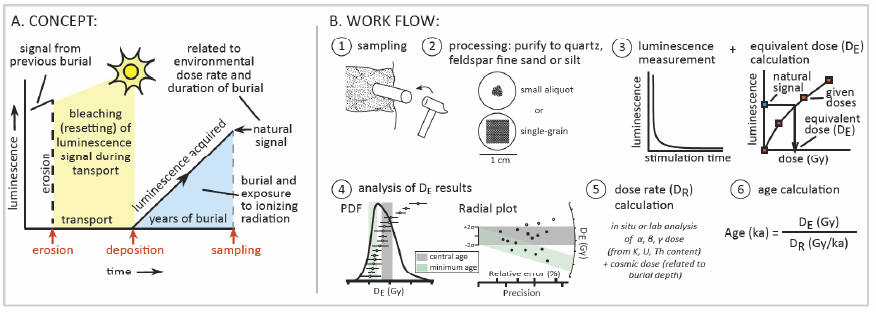What is OSL & IRSL?
OSL = optically stimulated luminescence of quartz
IRSL = infrared stimulated luminescence of feldspar
Luminescence geochronology is a late Quaternary dating technique used to date the last time quartz and feldspar sediment was exposed to light.

In geomorphology, as sediment is transported by wind, water, or ice, it is exposed to sunlight and zeroed of any previous luminescence signal. Once this sediment is deposited and subsequently buried, it is removed from light and is exposed to low levels of natural radiation in the surrounding sediment. Over time, quartz and feldspar minerals accumulate a luminescence signal as ionizing radiation excites electrons within parent nuclei in the crystal lattice. A certain percent of the freed electrons become trapped in defects in the crystal lattice of the quartz or feldspar mineral and accumulate over time (Aitken, 1998).
In our laboratory, these sediments are exposed to an external stimulus (blue-green light for quartz, infrared light for feldspar) and the trapped electrons are released. The released electrons emit a photon of light upon recombination at a luminescence center (hole, atom missing an electron). In order to relate the luminescence given off by the sample to an age, we first need to calculate the dose of ionizing absorbed during burial. Following the single-aliquot regenerative (SAR) method of Murray and Wintle (2000), the equivalent dose (De) is calculated by first measuring the natural luminescence of a sample. Then, the bleached sample is given known laboratory doses of radiation, referred to as regenerative doses (step 3 in figure below). The regenerative dose data are fit with a saturating exponential to generate a luminescence dose-response curve. The De is calculated by the intercept of the natural luminescence signal with the generated curve. A curve is generated for each aliquot (subsample), dozens of aliquots or hundreds of single-grains need to be analyzed to calculate the De for a sample to use in age calculation (step 4).
Luminescence dating is based upon the principle that the luminescence signal is proportional to the energy absorbed during burial from the flux of radiation to which a grain is exposed. The flux of radiation is the dose rate, which is derived from the radioactivity of the sediment and rock within 30 cm of the De sample.
Finally, the age of the sample is calculated by dividing the equivalent dose (De) by the dose rate of the environment surrounding the sample:
Age (ka) = Equivalent Dose (Gy) / Dose Rate (Gy/kyr)
Aitken, M.J., 1998, An introduction to optical dating: The dating of Quaternary sediments by the use of photon-stimulated luminescence: Oxford, University Press, 267 p.
Murray, A.S., and Wintle, A.G., 2000, Luminescence dating of quartz using an improved single-aliquot regenerative-dose protocol: Radiation Measurements, v. 32, p. 57-73.
Rittenour, T.M., 2018. Dates and Rates of Earth- Surface Processes Revealed using Luminescence Dating, Elements, Vol. 14, no. 1, p. 21–26. In Luminescence Dating: Reconstructing Earth’s Recent History, R. Smedley and A. Wintle (guest editors).

